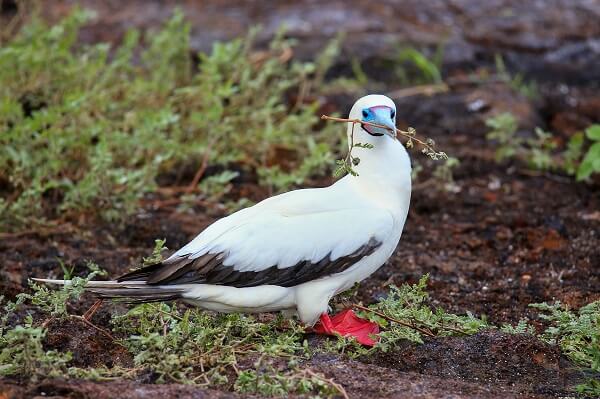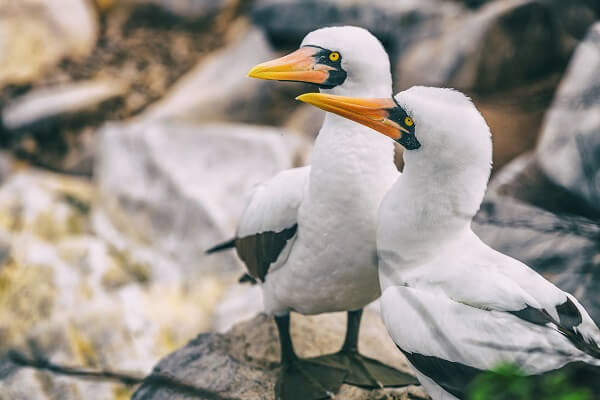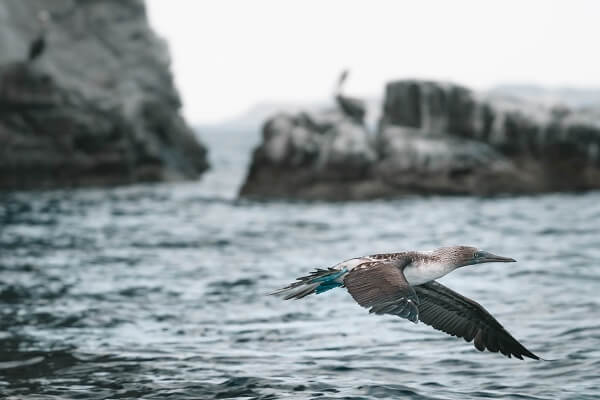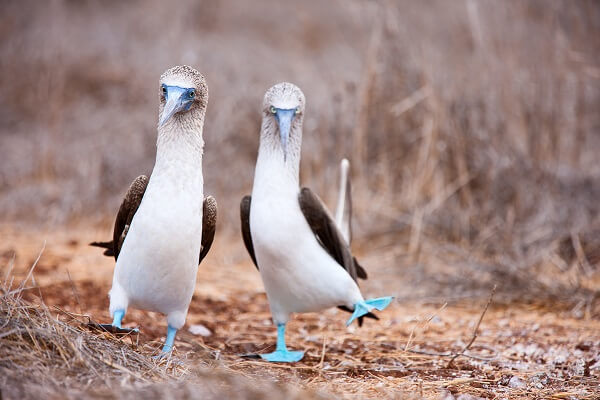
The booby is a large type of seabird that is closely related to the gannet. The birds are thought to get their name from the Spanish word “bobo,” meaning foolish or clown, which could be due to their clumsy and ungraceful appearance on land. When in flight, the booby is far from clumsy. These agile birds spend the day foraging at sea in search of small fish such as anchovies or sardines. They like to feed in groups, which could include as many as 200 birds. Unlike many other seabirds, they return to land to nest at night. There are six species of booby, and they are found throughout coastal regions of Central and South America and on tropical islands found in the southeastern Pacific. These birds have few natural predators. While owls and large birds of prey may steal booby chicks, the adults are too large. Humans are the main threat to these birds, although the occasional shark can also eat them. Boobies are traditionally grouped in the order Pelecaniformes. However, some taxonomists have suggested that they should be grouped in the order Suliformes based on genetic data. The order Suliformes includes cormorants, darters, and frigate birds. The six species of booby are similar in size and appearance but have distinct features that make them distinguishable from each other. The six species are the blue-footed booby, the red-footed booby, the brown booby, the Peruvian booby, the masked booby, and the Nazca booby. The blue-footed booby (Sula nebouxii) is the most well -known and is most commonly found on the Galapagos Islands and Ecuador. As the name suggests, these birds are distinguishable by their bright blue feet. They are the second largest of the booby species. Females are generally larger than males and also are more likely to have brighter colored feet. The red-footed booby (Sula sula) is slightly smaller and has bright red feet. It has a broad range and is found from the Galapagos Islands to the Caribbean. This bird is an agile flyer and can reach impressive speeds when diving to catch a fish. The fastest speed recorded is 60 miles per hour! The largest of the booby species is the masked booby (Sula dactylatra). This bird is found from the Caribbean islands to as far as Australia and can grow to nearly a meter in height. The Nazca booby (Sula granti) is found on islands in the eastern Pacific Ocean. It does not have brightly colored feet like its counterparts. It is instead recognizable by its white body and a bright yellow or orange beak. Adult brown boobies (Sula leucogaster) are chocolate brown with starkly contrasting white bellies and central underwings. They have pale bills and bright yellow feet. They can often be found close to shore and sometimes forage in very shallow or muddy waters. The Peruvian booby (Sula variegata) is as its name suggests native to Peru, but you can also find it in parts of Chile. It is the second most common seabird in Peru. It is not as elaborate in appearance as the other species. Boobies are birds that have adapted to foraging out at sea and living in large groups. As such, many adaptations exist that have enabled them to do so. These adaptations, and other traits, provide examples of some exciting concepts in biology. As seabirds, boobies spend most of their time out at sea and have become experts at foraging for fish in the ocean. Boobies are known for being exceptional divers. They hunt using surprise plunge attacks, diving directly into the ocean from great heights. Boobies are so good at diving that they can dive from as high at 100m above the water and dive 15m below the surface. There are several unique adaptations that these birds have that make this possible. The first thing that you notice about a booby is that it is very streamlined. It has long, narrow wings and a slender body. When the bird spots its prey, they fold the wings over their body and dive headfirst into the water in a swift vertical drop. Secondly, if you look at the booby’s bill, you will notice that there are no nostrils. This is because the nose is hidden under the upper mandible to prevent water from being forced into the bird’s trachea when it dives. Boobies also have internal airbags and a third translucent eyelid. The sacs of air are found under the skin on the bird’s face and chest and provide a cushion that protects the internal organs upon impact with the water. The third eyelid – called the nictitating membrane – provides protection from impact by extending over the eye just before a booby hits the water. Like many seabirds, boobies are colonial birds. They nest together in groups which can sometimes be very large and crowded. They typically mate with the same partner for several years. Although they live in colonies, boobies can be very territorial. They will protect their area within the large breeding colony through the use of elaborate displays, including head nodding and jabbing. Courtship also involves displays. The males will perform ritualized dances with many components, including whistling and raising their feet. The birds raise their feet alternately several times, followed by a gesture that ornithologists call sky pointing. Sky pointing involves the birds extending their wings horizontally and raising their heads before emitting a long whistle. If the female is impressed by the male’s display then mating will follow. Booby birds typically lay between one and three eggs. The incubation period lasts between four and five weeks. The elaborate courtship rituals described previously are not only used to attract a mate but are also an example of behavioral isolation. Also known as ethological isolation, behavioral isolation occurs when two populations are capable of interbreeding but don’t because of differences in their courtship rituals. Courtship rituals involve various signals including audio signals such as breeding calls, visual cues such as mating dances, and olfactory signals such as pheromones. Differences between these signals are what set the species apart. These differences in their elaborate courtship rituals isolate them from other, closely related species. Lets us consider how this relates to the booby bird. The six species of booby bird overlap and several species can be found sharing the same habitat. The differences in their mating rituals help them to find the correct mating partner and prevent them from mating outside of their species. By preventing interbreeding, behavioral isolation ensures that the bird does not waste effort in searching, courting, and mating with a partner that will not produce fertile offspring. Producing a fertile offspring is necessary for the continuation of a species, and so behavioral isolation is a fundamental biological mechanism.
Kingdom
Animalia
Phylum
Chordata
Class
Aves
Order
Pelecaniformes or Suliformes
Family
Sulidae
Genus
Sula
Species
Six
Niche
Variable, some feed inshore while others far out to sea.
Length
64cm – 91cm
Weight
0.9kg – 1.8kg
Lifespan
12 – 17 years
Social Structure
Live in colonies
Conservation Status
Least Concern
Preferred Habitat
Coastal and ocean areas
Average clutch Size
Two eggs
Main Prey Species
Small fish such as sardines and anchovies, and squid
Predators
Humans, owls, and birds of prey
The Basics

Six Species of Booby
Interesting Insights from the Booby Bird!

Feeding Adaptations
Courtship Rituals

Behavioral Isolation
